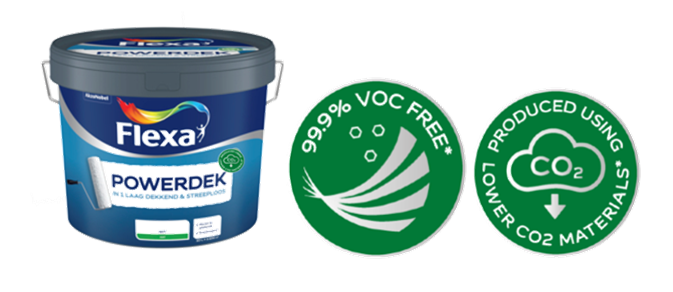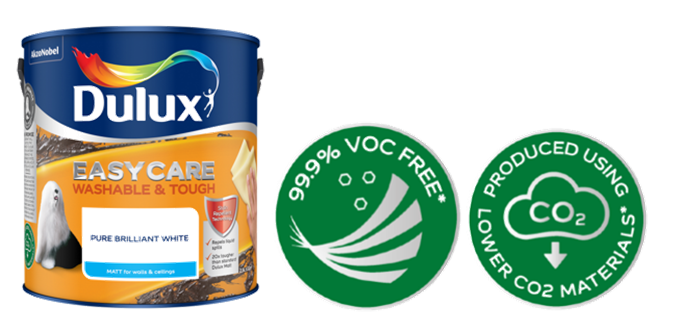At AkzoNobel, we have ambitious sustainability ambitions. Luckily there are more and more of our customers thinking alike.
Our sustainability approach focuses on systematically reducing the major drivers of our carbon footprint. This means exploring how to use less solvents (Volatile Organic Compounds contributing to greenhouse gases), cutting down our use of titanium dioxide without reducing spreading rates, using lower carbon footprint binders, embedding more recycled raw materials and extending the lifetime of our paints. All of this will contribute to our ambition of achieving 50% reduction of our scope 1,2 and 3 carbon emissions by 20301.
An example of our determination to implement this approach is how we have addressed the sustainability of some of our largest ranges in the Europe, the Middle East and Africa region (EMEA). Two of our European hero propositions, Flexa Powerdek and Dulux Easycare, account for a significant part of our carbon footprint due to their high-volume sales. We are therefore focusing on these products to drive our carbon footprint reduction.
Flexa Powerdek in the Netherlands
A mainstream white wall paint with sustainability credentials without compromise
3 years ago our Flexa brand launched its flagship Powerdek walls & ceiling white wall paint in its reduced carbon footprint variant. Thanks to the biomass balance2 approach this REDCert2 certified paint offers a 6% carbon footprint reduction compared to the same paint produced with 100% fossil based raw materials. This results in an estimated 475 tones CO2eq saving per year3, which represents 268 return journeys from Paris to New-York by plane (source – ADEME - Comparateur carbone | Impact CO₂).
A biomass balance approach was selected for its certified lower carbon footprint benefit while allowing us to remain cost competitive for consumers.
Being 99.9% VOC free, Flexa Powerdek demonstrates that a wall paint can be commercially successfully for our distributors, offer consumers great benefits and be more sustainable.

Dulux Easycare
THE sustainable choice by excellence for our consumer
AkzoNobel is also upgrading its hero consumer durability proposition Dulux Easycare. In Q2 2025 Dulux Easycare Washable & Tough will be upgraded in the UK market by becoming 99.9% VOC free and being produced with reduced carbon footprint raw materials (following the mass balance principle) without compromising on its durability and toughness performance. The biomass balance approach was selected for its certified lower carbon footprint benefit while allowing us to use the exact same proven specific binder technology needed to deliver our targeted performances on durability.
With this upgrade, Easycare is becoming THE sustainable choice for our consumers thanks to its:
- Improved indoor air quality (99.9% VOC free, producing less emissions versus the prior version)
- Lower carbon footprint, when compared to the same paint formula produced with 100% fossil-based raw material. An average reduction of 5-7% depending on the colours is delivered.
- More durable than standard core paint offering an extended lifetime and longer intervals between maintenance cycles.
This upgrade will deliver an overall annual carbon footprint reduction versus the current version on the market of about 4,500 tonnes CO2eq per year4. This equates to driving around the earth 500 times by car (source – ADEME - Comparateur carbone | Impact CO₂).

1 Our carbon footprint reduction targets apply to our decorative paints and for the coatings used to coat consumer DIY products such as electrical equipment, furniture, domestic appliances and lighting sold in the DIY value chain
2 In the production process of our raw materials, fossil based ingredients are partially replaced with their renewable equivalent. The renewable content is then allocated to a specific product grade. An independent body ensures that the quantity of renewable material used and claimed in the entire manufacturing process is respected. The supplier only sells to us renewable materials (mass balance grade) up to the maximum allowed by how much renewable content was put it.
This principle is actually similar to the principle of "green electricity". Subscribers cannot be sure that the electricity coming to their homes comes from renewable sources, as different sources are mixed in the final distribution grid. However, they buy a guarantee that the amount of energy they consume will be fed into the grid in a "renewable version"
Example BASF: Biomass balance approach
3 Considering 2024 volumes
4 Considering 2024 Volumes
